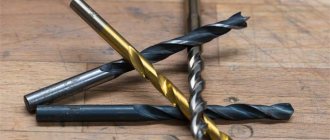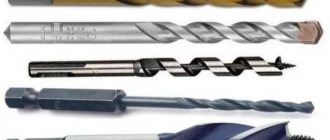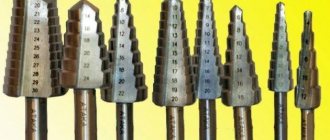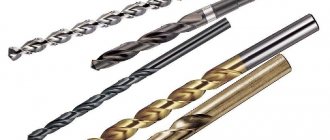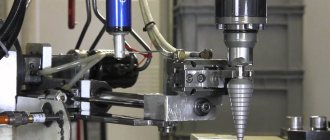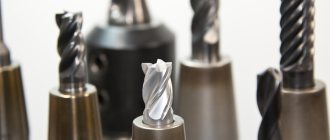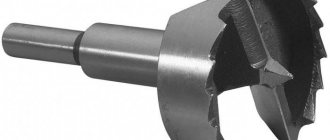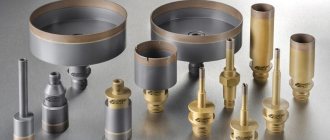SHARE ON SOCIAL NETWORKS
FacebookTwitterOkGoogle+PinterestVk
The modern market is distinguished by a variety of tools used for all types of work. Cone drills for metal are professional products that are characterized by a long service life, versatility and ease of use. To select the necessary tool, it is recommended to study the basic properties of such devices.
Cone drills for metal are characterized by versatility, long service life and ease of use
Application area
Conical metal drills are used to make holes in sheet and thin-walled metal. Typically, the thickness of the metal being processed is from 1 to 4 millimeters and depends on the height of the drill step. If the height of the step is 4 millimeters, then the maximum thickness of the sheet or rolled metal that can be processed will be, respectively, 4 millimeters. A step drill allows you to work even with thin sheet metal.
The main difference from other types is that with the help of one drill you can get several standard sizes of holes at once.
Note that there are also conical drills for processing not only metal, but also wood, plastic, drywall, and textolite.
A conical drill (sometimes craftsmen call it a carrot drill) is also distinguished by the fact that when used correctly, the hole has virtually no defects. Proper use of the tool allows you to obtain smooth walls and edges of the hole, the absence of burrs and cracks. After drilling, there is no need for additional hole processing. Therefore, craftsmen often use them to correct defects in holes made with another type of drilling tool.
A high-quality metal cone drill bit has hard, sharp edges, which allows it to work with metal of high density and hardness. Some drills also have an abrasive coating, which further increases their effectiveness. Where another tool is powerless, it is often very convenient to use this type of drill.
The cone drill has a sharp tip, which allows the drilling operation to be carried out without preliminary core punching and additional centering.
Why does an electrician need a step drill for metal?
A step drill can be used by an electrician. He needs this device when installing electrical wiring. For example, an electrician must drill a hole in a steel profile to thread a wire through the plasterboard sheathing. The thickness of the metal profile sometimes reaches 0.5 mm. The diameter of the cable to be passed through is 16 mm. It is difficult to drill this profile with a simple tool, since the holes will come out uneven. Using a multi-stage option, you can make a hole in a workpiece with a thickness of 16, 20, 25 mm.
Step drills are necessary for electricians to work in electrical panels. It is often necessary to drill a hole in the panel to install control buttons, indicators, various switches, fittings or a lock. The electrical panel is 1 mm thick. Installing the seal on the shield requires drilling a large opening in the shield.
The stepped product makes openings in metal cable boxes for wire exit. If the openings in the box for removing the wire are rigidly fixed, then it is necessary to make an additional hole for installing the gland and plug.
Types of stepped (conical) drills
As noted, cone drills come with a smooth transition of diameter and with a step, stepped one. Step drills are most widely used, since they make it possible to obtain a hole of a strictly defined size with smooth walls. A hole made with a smooth tapered drill will always have a slight slope. In the case of working with thin sheet metal, this will be hardly noticeable.
In general, the quality of step drills can be classified by color:
- Metallic grey. Typically, such a tool is made of low quality tool steel. No additional heat treatment was provided during its manufacture either. There is no abrasive coating on the surface of the drill. Such drills should not be purchased if they are expected to be used regularly, as well as to work with thick and durable metal.
- Drills are black. Such a tool was subjected to heat treatment during production. Steam treatment and subsequent hardening were carried out. This treatment increases the hardness of the tool and increases its service life. But it is still not recommended to use such drills with stainless and other high-strength steels.
- Dull golden color. A step drill for metal, which has a pale yellow color, is made of metal with the addition of alloying additives, most often cobalt. Such a tool is subjected to hardening and subsequent tempering, which relieves internal stress and increases the strength and durability of the tool. Drills of this color can be used to process durable alloy and stainless steels.
- Bright golden hue. Tools of this color are the highest quality and are designed to work with thick-walled, high-strength steels. The steels from which the tools are made are obtained by adding titanium nitride and subsequent heat treatment.
What to look for when choosing a conical drill
You should make a choice of a tool such as a conical drill for metal only after you have become familiar with its characteristics. The color of a step drill can tell you a lot about it.
- The gray-steel color of the manufacturing material indicates that the drill has not been subjected to any heat treatment; therefore, you should not count on its high quality.
- The conical tool, the surface of which is black, has been treated with hot steam, which increases its strength.
- The golden color of the steel indicates that all internal stresses in the metal were previously eliminated, which improved its quality characteristics.
- If the surface of a step drill has a bright golden hue, it is highly wear-resistant. This is provided by the titanium nitride contained in the metal. The fairly high cost of such products is fully compensated by their long service life.
The marking of a step drill indicates its characteristics
For the production of cone drills, various types of steel are used, which are determined by marking. If the marking contains the abbreviation HSS, this means that with this product you can perform high-speed processing without worrying about it deforming or losing its strength characteristics under intense heating.
When choosing a step drill, pay attention to the main dimensions
When choosing cone drills, you must also consider the following parameters:
- diameter, which completely depends on the characteristics of the holes that need to be obtained;
- brand (this parameter largely determines not only the quality of the product, but also its cost);
- compliance of the purchased conical drill and the material from which it is made with all GOST requirements;
- possibility of multiple sharpening (here you should be guided only by your own preferences and experience in sharpening spiral and conical drills in accordance with GOST requirements).
Shape and dimensions
All cone drills for metal, as already mentioned, have a cone shape and can have a smooth or stepped diameter transition. The most widespread among mechanics is the step metal drill.
This is due to the fact that it is easier for them to work, since the transition from size to size when drilling is clearly visible, and achieving the desired diameter will not be difficult. The resulting hole has a fairly high surface quality and does not require additional finishing. And a fairly smooth transition from one step to another forms a chamfer for a pre-drilled hole.
Step drills differ in the number of steps, their height, diameter range and pitch. Typically, the diameter of the smallest drill step is 4 millimeters. The maximum size of the hole that a stepped tool can drill is up to 40 millimeters. The standard step height is 4 millimeters. This value determines what thickness of metal the tool can process.
The successive increase in diameter can be 2 or 3 millimeters. The standard step is 2 millimeters. Typically, if a cone drill has a wide range of diameter sizes (for example, from 4 to 40), then the step in this case can be 3 or 4 millimeters.
In specialized stores you can find step drills with a different range of diameters, so they should be selected for a specific set of tasks.
In addition to the working part of the drill, the tool also differs in the shape and size of the shank. The shank can have a cylindrical shape of various diameters, a hexagonal or triangular shape, as well as a specialized profile for specific connectors from hand tool manufacturers. A step drill for metal can be installed on a screwdriver, hammer drill or drilling machine.
Speeds/min. step drill for drilling machine
| Material | Steel | alloy steel | Cast iron | Aluminum |
| Ø, mm | RPM | RPM | RPM | RPM |
| 4,0-12,0 | 1700-580 | 1550-520 | 800-250 | 2350-790 |
| 4,0-20,0 | 1700-350 | 1550-300 | 800-160 | 2350-470 |
| 12,0-20,0 | 600-350 | 520-300 | 250-160 | 790-470 |
| 4,0-24,0 | 1700-280 | 1550-250 | 800-130 | 2350-400 |
| 6,0-30,0 | 1200-230 | 1000-200 | 530-100 | 1590-310 |
How to use a step drill for metal
- For more accurate positioning, it is better to mark the hole with a core to prevent slipping.
- Use machine oil or special products (spray, pencil) to lubricate the drill from overheating during operation.
- For high-quality drilling, it is better to use a drill from 3000 rpm. and higher, with an additional handle to avoid distortions.
- When drilling a hole of a larger diameter, you need to slowly reduce the speed so that the hole does not become larger in diameter due to chamfering with the conical part.
Marking features
Step drills for metal may not always be marked. You should not look for markings on cheap Chinese tools or domestic drills of dubious manufacture. Such manufacturers can sometimes put on drills or their packaging only symbols that they understand, which do not characterize the tool in any way, but serve only for internal classification. But a high-quality professional tool from a trustworthy manufacturer always has a marking.
In the standard case, proper marking should contain in its designation all the main dimensions of the tool, material of manufacture, as well as characteristics of hardness or strength.
Let's take an example of the marking designation ø4-20/2 HSS4241-Co HRC 62.
This cone drill marking should be read as follows:
- ø4 – diameter of the first smallest stage of the tool (diameter of the smallest hole that can be obtained);
- ø20 – diameter of the last largest step of the tool (diameter of the largest hole that can be obtained);
- 2 – diameter pitch value (4-6-8-10-12-14-16-18-20);
- HSS 4241 – designation of the material from which the tool is made. HSS (High Speed Steel) – high-speed steel, 4241 – steel grade;
- Co – the material from which the tool is made contains cobalt, which gives it strength and durability;
- HRC 62 – Rockwell hardness value.
But most often, instead of marking, the manufacturer indicates on the packaging the main characteristics of a cone drill for metal. Moreover, the description of the characteristics is often accompanied by explanatory images to facilitate consumer understanding.
Advantages and disadvantages of these drills
In order to summarize the material presented and help you make a decision about the need to purchase a step drill, we will highlight the positive and negative aspects of this type of tool.
The advantages include the following characteristics:
- one stepped cone drill can replace a whole set of drilling tools (up to 16 ordinary drills);
- the resulting holes have a very high surface quality, which makes subsequent finishing processing unnecessary;
- ability to work with thin sheet steel;
- savings on purchasing a full set of drill sizes;
- cone drills have a short length compared to other types of drills, which simplifies the work;
- high-quality drills have high reliability and durability;
- the ability to drill at high speeds improves process productivity.
Among the disadvantages of step drills, we highlight the following features:
- Compared to other types of drilling tools, cone drills have a higher cost;
- when working with smooth conical drills, obtaining an exact diameter value is quite difficult even for a professional;
- to work with this type of tool you need to have certain skills;
- Sharpening stepped cone drills is quite difficult, especially at home.
How to properly drill holes with a cone drill instructions
To learn how to drill correctly with cone drills, you must first prepare the necessary tools and materials. For work you will need the following materials and tools:
- Blank for drilling. These are sheet steel, plastic, glass, wood, etc. The workpiece must be securely secured in the jaws of a vice or a clamp.
- Drill - any power tool that can develop a rotation speed of 3-5 thousand revolutions per minute is suitable. In this case, it is recommended to attach an additional handle to the drill, which will avoid distortion. Drilling is performed in non-impact mode
- Cone drill of suitable diameter. Depends on the hole that needs to be drilled in the workpiece
After this, we proceed to the actual work. The drilling instructions are as follows:
- The nozzle is fixed in the tool chuck
- Select the location where you want to drill a hole
- The tool is applied to the surface being processed strictly in a perpendicular direction
- The tool motor starts. The first seconds of drilling into metal help center and cut a small hole. As soon as the drill begins to go deeper into the hole, the diameter increases with each subsequent revolution. At the same time, the speed of work execution increases
- The end result is a neat hole without chips, burrs or other defects.
It is enough to try the attachment in action once and then stop using cylindrical drills when processing sheet materials. How a conical drill shows itself in action when drilling plastic, plexiglass, metal and other materials is shown in the video clip.
How to choose the right step drill?
To choose the right step drill, you need to decide on the purposes for which the tool will be used. Thus, it is necessary to determine what size holes need to be drilled. The values of the smallest and largest diameters that are planned to be made are especially important.
You should also decide on what hand tool or machine the drill will be used. The type of shank that should be on the drill depends on this. Therefore, you should carefully study the drill chuck connector and clearly know the shape and dimensions of the shank. If the shank does not fit the existing connectors, you will have to separately purchase a special adapter.
It is important to decide on the manufacturer and level of the tool. As already noted, bright golden-colored stepped conical drills are made with cobalt and titanium impurities, with an abrasive coating and have high hardness. They will last longer and allow you to work with thick rolled products, stainless and alloy steels.
Look for the HSS designation on the label or packaging, which means the drill is made of high-speed steel. Try not to buy dubious Chinese-made drills.
How to sharpen cone drills?
Cone drills are expensive, but at the same time quite reliable and durable cutting tools.
But in any case, after some time, their cutting edges become dull, and the tool loses its characteristics. Some step cone drills are designed to be sharpened, and some are not sharpened. Those that are not intended for sharpening are characterized by high quality cutting edges and durability. If the drill has a straight longitudinal groove, then sharpening can be done manually. If the groove is spiral-shaped, then sharpening should be done on a sharpening machine using an abrasive wheel. It is important to maintain the angle and dimensions of the cutting edge on each step drill diameter. The abrasive wheel used for sharpening must be fine-grained. If you have a similar drill at hand with non-blunted edges, you can take it as a template and focus on its dimensions and the profile of the cutting edge.
Self-sharpening
Drills, which are called stepped or conical, allow you to create holes with a diameter of 4 to 32 mm and are available in two versions: with the ability to sharpen or with a design that does not involve this technological operation. The high cost of products belonging to the second type is justified by their durability.
Their cutting edge (subject to all operating rules) does not become dull for a long time. It should be borne in mind that sharpening them without the appropriate experience can only lead to the fact that they become unsuitable for further use.
Cone drills of a certain configuration can be sharpened with a triangular abrasive rod
In order to properly sharpen a step drill, just watch the training video and follow the recommendations of qualified specialists. To perform this procedure, you don’t even have to rely on the drawing, but simply restore the original geometric parameters of the product.
Also, in some cases, it is permissible to use for these purposes thin abrasive diamond bars intended for sharpening knives, scissors and other tools.
Such a tool, like spiral drills with a conical shank, can be sharpened using a special machine equipped with an abrasive wheel, the working surface of which can be covered with ordinary sandpaper.
The geometric parameters of step drills, the guide grooves of which have a rectilinear shape, can be restored manually, and products with spiral grooves are best processed using a sharpening machine. It should be borne in mind that it is easiest to restore the geometric parameters of high-quality step drills.
